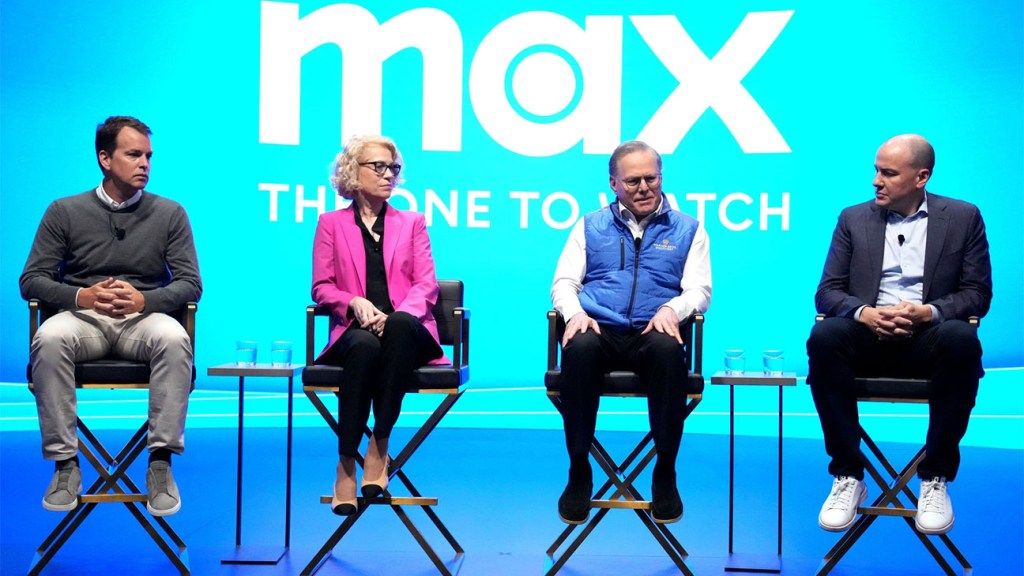Warner Bros. Discovery Narrows Streaming Loss to $3M, Posts Sub Drop Amid Max Rebrand, Ups Post-Merger Cost Savings Target to $5B-Plus
Warner Bros. Discovery, which has been a top pick of several analysts, reported a much narrowed quarterly streaming loss on Thursday, just short of reaching its second streaming profit in a row, as it posted its latest financials.
Advertising in the latest period fell sharply amid a challenged ad market, but slightly exceeded experts’ expectations. Warner Bros. Discovery, which has been laying off staff to “right-size” its post-merger business, also disclosed pre-tax restructuring expenses for the second quarter and raised its post-merger cost savings target from $4.0 billion previously to “more than $5.0 billion.”
The Hollywood giant finished the second quarter ended in June with 95.8 million global streaming subscribers, down 1.8 million from 97.6 million as of the end of the first quarter in March amid the impact of combining Discovery+ and HBO Max into new streamer Max starting in May, it disclosed on Thursday. Analysts have predicted a user drop in the latest and upcoming quarters amid the change in streaming brand, packages and prices.
Ahead of the earnings report, Goldman Sachs analyst Brett Feldman had highlighted the overlap of around 4 million subscribers of HBO Max and Discovery+, which management has expected to “roll off of the standalone Discovery+ platform within the first few months of the May Max launch,” as he pointed out in a research report. “We update our domestic net add cadence to reflect a second-quarter weighted net loss (2.0 million in the second quarter and 1.0 million in the third quarter), as well as flat international net add growth for the same period ahead of the fourth-quarter Latin America Max launch.”
The Goldman expert lowered his Warner Bros. Discovery (WBD) stock price target by $1 to $20 “on lower near-term estimates related to studios underperformance (notably, The Flash) and linear headwinds within the networks segment, partially offset by the impacts of WBD’s strong free cash flow in the second quarter and strong box office expectations for Barbie,” which opened in theaters in the third quarter.
The entertainment conglomerate’s streaming unit hit a $3 million loss in the second quarter, compared with a loss of $558 million in the year-ago period, after recording a $50 million profit in the first quarter. Streaming revenue rose 13 percent to $2.73 billion in the second quarter, led by a 25 percent advertising gain, helped by year-over-year subscriber growth from 92.2 million as of the end of June 2022. At the same time, costs of revenues fell 6 percent and selling, general and administrative expenses dropped 13 percent.
In May, Warner Bros. Discovery CEO David Zaslav had shared that the conglomerate was expecting its U.S. direct-to-consumer business to be profitable for the full year 2023, a year ahead of its previous guidance. After all, management has vowed to make the streaming business sustainably profitable, including by not chasing subscribers at all costs. WBD investors are expected to take the Thursday update as a confirmation that the company is making good on its promise to take a leadership role in the industry’s push toward streaming profitability.
The company’s quarterly earnings before interest, taxes, depreciation and amortization (EBITDA) saw a 22 percent increase to $2.15 billion, helped by the streaming upside surprise, while its net loss narrowed from $1.86 billion to $1.24 billion. It included $1.66 billion of “pre-tax amortization from acquisition-related intangible assets and $146 million of pre-tax restructuring expenses,” the company said. Second-quarter revenue dropped 4 percent to $10.36 billion.
WBD’s Studios unit EBITDA fell 25 percent in the second quarter to $306 million amid a 23 percent revenue drop to $2.58 billion and came in below estimates due to a difficult comparison with the year-ago quarter, which had benefited from strong The Batman theatrical and home entertainment results, which The Flash and Evil Dead Rise couldn’t match in the latest period. Also hitting studios division profits in the second quarter were marketing costs for the third-quarter hit release Barbie.
While Studios division expenses fell, TV revenue declined, “primarily due to the timing of production, fewer CW series, and fewer series sold to our owned platforms,” and games revenue came in lower “due to the release of Lego Star Wars: The Skywalker Saga in the prior year.”
In the firm’s Networks unit, advertising revenue fell 13 percent excluding foreign currency exchange hits, “primarily driven by audience declines in domestic general entertainment and news networks
and soft advertising markets mainly in the U.S. and, to a lesser extent, certain international markets.” The company also noted: “Additionally, the absence of the NCAA March Madness Final Four and Championship this year, which we broadcast in the prior year, negatively impacted the year-overyear growth rate, partially offset by the broadcast of the NHL Stanley Cup Finals in the current year.”
Distribution revenue also decreased by 1 percent as increases in U.S. contractual affiliate rates were more than offset by declines in U.S. pay-TV subscribers.
Overall Networks unit EBITDA fell 8 percent to $2.17 billion, driven by a 6 percent revenue decrease to $5.76 billion.
WBD’s overall EBITDA beat though also allowed the company to exceed free cash flow forecasts for the second quarter. Free cash flow is a key metric that management and analysts are keeping a close eye on as the company continues to pay down debt after the megamerger that created it. WBD previously said it has paid down $9 billion in debt paid so far. On Thursday, it said in a separate press release that it plans to retire up to around $2.7 billion in additional debt.
The megamerger between Discovery and WarnerMedia, previously owned by AT&T, that created the Hollywood giant closed in April 2022. “We’ve come through some major restructurings and have repositioned our businesses with greater precision and focus,” Zaslav said in May. “And we see a number of positive proof points emerging, with direct-to-consumer perhaps the most prominent.”
On Thursday, the CEO highlighted: “The important work we are doing to transform our businesses for the future continues to drive our strong financial performance as demonstrated by meaningful improvements to our balance sheet and our now increased synergy target of more than $5 billion. This quarter alone we reported over $1.7 billion in free cash flow, and we remain bullish with respect to our delevering story and expect to be comfortably below 4 times levered by the end of the year and at our target of 2.5-3.0 times gross leverage by the close of 2024.”
Wells Fargo analyst Steven Cahall in a first reaction noted this as one key takeaway from the earnings update, using the headline: “Deleveraging Like a Boss.” WBD shares were up more than 3 percent in pre-market trading.
Zaslav in Thursday’s earnings report also touted room for upside ahead, saying: “All of [this] positions us well to lean into growth opportunities that will ultimately drive shareholder value, to include our direct-to-consumer business, which, in the wake of the successful launch of Max in the U.S., is tracking well ahead of our financial projections, having generated positive EBITDA in the first half of the year.”
Source: Hollywood Reporter


